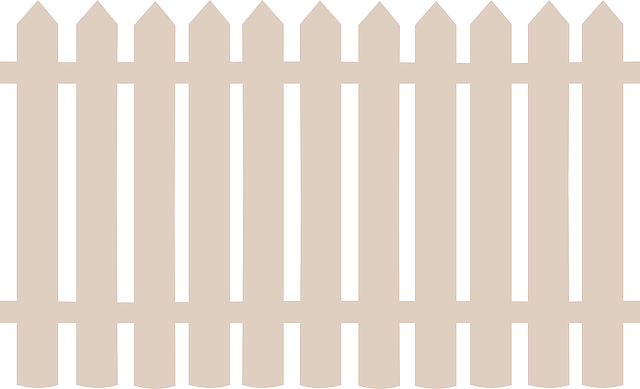Maintaining a privacy fence is an essential aspect of homeownership, offering both security and aesthetic appeal. For New Bedford residents, keeping your fence in top condition requires a strategic approach. This article guides homeowners through the process of maintaining their privacy fences, from understanding their purpose to addressing common issues. By following a regular cleaning schedule, inspecting for damage, and implementing effective treatment methods, you can extend the lifespan of your fence while ensuring it continues to provide the privacy and safety you desire.
- Understanding Your Privacy Fence's Purpose
- Regular Cleaning and Maintenance Schedule
- Inspecting for Damage and Wear
- Treating Common Fence Problems
- Tips for Extending Fence Lifespan
- When to Consider Replacement
Understanding Your Privacy Fence's Purpose
A privacy fence serves as more than just a physical barrier; it’s designed to create a sense of seclusion and security for your New Bedford home. By understanding its purpose, homeowners can better appreciate the need for regular maintenance. These fences act as buffers between your personal space and the outside world, allowing you to enjoy your outdoor areas without unwanted intrusions. Whether it’s protecting your privacy from neighboring properties or providing a safe play area for children, regular upkeep ensures that this essential component of your property remains effective.
Proper care extends the life of your fence, maintaining its functionality and aesthetic appeal. Regular cleaning, inspection for damage, and timely repairs are key components of upkeep. By keeping an eye on potential issues like rot, warping, or broken boards, homeowners can address problems before they compromise the integrity of the fence.
Regular Cleaning and Maintenance Schedule
Regular cleaning and maintenance are key to keeping your privacy fence in top condition. Start by sweeping or brushing away any accumulated dirt, leaves, or debris at least once a week. This prevents buildup and keeps the fence looking neat. Use a soft-bristled brush or broom to avoid damaging the fence material.
Additionally, inspect your fence regularly for signs of wear and tear, such as loose or missing pickets, rusted hardware, or cracks in the wood. Address these issues promptly to prevent further damage. Depending on the material and climate, a yearly deep clean with a pressure washer and a fresh coat of paint or sealant can also help extend the life of your privacy fence.
Inspecting for Damage and Wear
Regularly inspecting your privacy fence is an essential part of maintenance. New Bedford’s unpredictable weather can take a toll on outdoor structures, so it’s crucial to be vigilant. Look for any signs of damage, such as broken boards, loose posts, or rusted hardware. These issues might seem minor but can escalate if left unattended, leading to more extensive repairs or even structural failure.
During your inspections, pay close attention to areas prone to wear and tear, like the bottom rail and gate hinges. Ensure all components are securely fastened and in good condition. Keep an eye out for signs of rot, especially in wooden fences, as this can compromise the fence’s integrity. Addressing damage early will help extend the life of your privacy fence and ensure it continues to provide the seclusion you desire.
Treating Common Fence Problems
Fences, despite their sturdy appearance, are prone to issues over time, especially in New Bedford’s varying climate. One of the most common problems is rot, often caused by moisture and wood species sensitive to water absorption. Regular inspection is key; look for soft or peeling sections, which might indicate rot. Treating these early can prevent further damage.
To address rot, remove any affected boards and replace them with fresh, pressure-treated wood. Ensure proper drainage around the fence to minimize water accumulation. Another frequent issue is loose or broken posts, typically due to shifting soil or weather conditions. Reinforcement with concrete anchors or adjusting post placements can solve this problem effectively.
Tips for Extending Fence Lifespan
Regular cleaning and maintenance are key to extending the lifespan of your privacy fence in New Bedford. Start by sweeping or brushing away any loose debris, leaves, or grass clippings that accumulate on top of the fence. Use a soft-bristled brush for wooden fences to gently remove stains and fading caused by sunlight exposure. For metal fences, use a mild detergent and warm water to clean off rust and dirt build-up.
Applying a fresh coat of paint or sealant annually will protect your fence from the elements and prevent rot, peeling, or corrosion. Check for any signs of damage such as broken boards, loose posts, or rot and repair these issues promptly to avoid further complications. Regular inspection and maintenance will ensure that your privacy fence remains functional and aesthetically pleasing for years to come.
When to Consider Replacement
If your New Bedford fence has seen better days, it might be time to consider replacement. Over time, fences can deteriorate due to weather exposure, pest damage, or regular wear and tear. Look out for signs such as rotten posts, warped panels, or loose rails, which indicate that the fence is no longer structurally sound. Additionally, if your fence has become an eyesore or fails to provide the privacy you desire, replacement might be a sensible option.
Regular maintenance can often delay the need for full replacement, but there comes a point when it’s simply not cost-effective to repair an old fence. At this stage, investing in new materials and professional installation can offer long-term solutions, ensuring your property remains secure and aesthetically pleasing.
